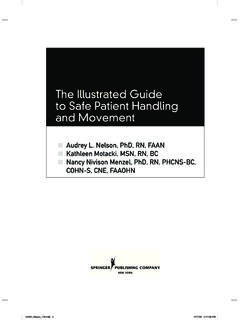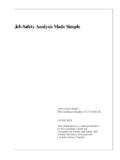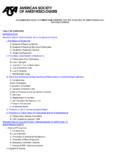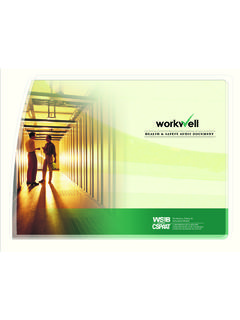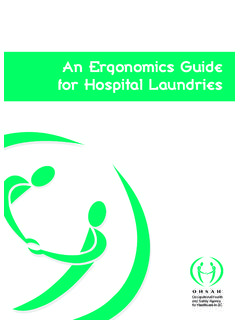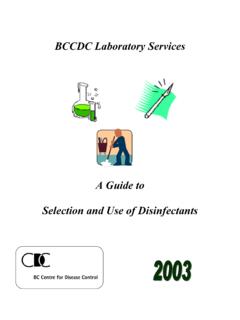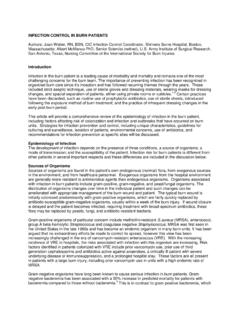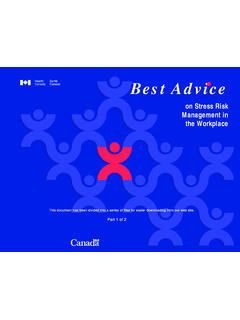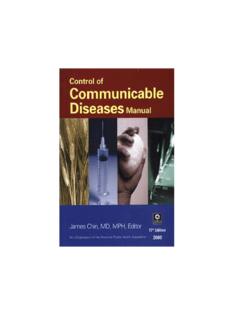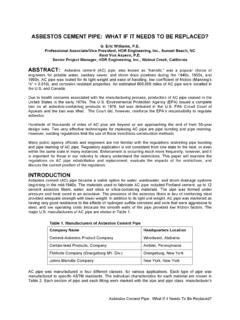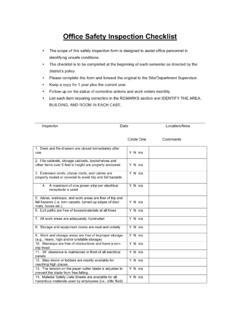Transcription of Checklists for inspecting the workplace
1 Westcentre 1260 Hay Street West Perth WA 6005 Telephone: 1300 307 877 Facsimile: (08) 9321 8973 Email: Checklists for inspecting the workplace Using this document WorkSafe has produced Checklists to assist you in inspecting your workplace for hazards. Although the Checklists do not cover all the requirements under workplace safety and health laws, they will give you a better idea of whether your workplace meets basic standards of safety. They will also assist in laying the foundation for a safety and health management system in your workplace . Most of the Checklists included in this document will be relevant across most industries, however industry specific checklist are available from the WorkSafe website: publications Checklists In this document you will find: Chemicals and harmful substances; Electricity Health topics - Manual tasks - lifting; - Slips and trips; - Violence, aggression and bullying Human factors; - Evacuation; - New and young workers; New and young workers safety induction; Work experience; - Managing contract and transient workers; Machinery and plant; - Forklifts; - Guarding.
2 - Machinery and plant Noise Work practices - Confined space; - Working at heights; - Working alone OSH system checklist 2 Chemicals and harmful substances - safety checklistcheck yes no n/a Correct use of chemicals and harmful substances is part of induction All people who may be exposed to chemicals and harmful substances have been given information, instruction and training Records of training include.
3 Health effects, controls, safe work methods and personal protective equipment/clothing There is a complete easy to find and read list/register of all chemicals used There is an up to date MSDS for each hazardous substance in the workplace MSDS are available for workers reference and included in the hazardous substances register Original containers have the manufacturer's label Decanted containers are labelled with name, risk and safety instructions A risk assessment has been completed for all chemicals and harmful substances stored and used at the workplace The risk assessment is recorded in the list/register Risk assessment reports are available where risks are significant Actions have been taken to control risks.
4 The hierarchy of controls has been considered when reducing risk controls such as eliminating the chemical, choosing a safer one or using ventilation near the work are used where possible Controls are inspected and maintained (eg air flow checked in ventilation systems) There are appropriate first aid and emergency facilities and workers are aware of them Where there is a risk from lead, isocyanates, asbestos, organophosphate insecticides and other scheduled chemical, a doctor has been appointed to monitor the health status of workers. Other sources of information: y The Occupational Safety and Health Regulations y Spray painting-Code of practice y Styrene Code of practice y OSH management and contaminated sites-Guidance note y Prevention of carbon monoxide poisoning-Guidance note y Soldering in the workplace -rosin fluxes-Guidance note y Safe use of chemicals in the woodworking industry-Guidance note y Controlling hazards in the electroplating industry-Guidance note y Controlling isocyanate hazards at work-Guidance note y Material safety data sheets (MSDS)
5 -Guidance note y National Code of Practice Synthetic Mineral Fibres y National Code of Practice Inorganic Lead at Work y National Code of Practice Scheduled Carcinogenic Substances y National Code of Practice - Control of Hazardous Substances y National Code of Practice Labelling of workplace Substance y National Code of Practice Ethylene Oxide in Sterilisation y National Code of Practice for the Safe Use of Vinyl Chloride y National Guidance Note Assessing risks of hazardous substances y National Guidance Note workplace hazardous substance in retail y National Guidance Note Exposure standards y WorkSafe website Chemicals and harmful substances 3 Electricity safety checklistcheck yes no n/a Electrical safety is part of induction People working with electricity have been given information, instruction and training There is a maintenance program in place for electrical installations Electrical equipment has been tested Residual current devices (RCD)
6 Are installed at switchboards or into fixed sockets Portable electrical equipment is protected by RCDs The RCD device is labelled and has been tested Flexible cord connections have either moulded or transparent type plugs Plugs, sockets and extension leads are in good condition Flexible cords are protected from water, being damaged or cut Switchboards are labelled correctly and protected from damage Light fittings are suitable for the location and protected from breakage Power points are suitable for the location and are positioned safely Safety procedures are in place for workers working near overhead power lines Machinery has been identified that may expose workers to electrical risk Site power been connected when construction site work has reached plate height Cords are of suitable length for the intended use There are no double adaptors or three-pin plug adaptors in use Electrical
7 Installations are protected from damage that would increase the risk of electrical shock or fire Portable cable stands are used when required On construction and demolition sites also check: Portable electrical equipment has been tagged There is a record of previous testing All final sub-circuits, socket outlets, portable generators and equipment are protected by RCDs No aerial cables are fixed or attached to scaffolding Other sources of information: y The Occupational Safety and Health Regulations WorkSafe website Electricity 4 Manual tasks-lifting safety checklistcheck yes no n/a Lifting and carrying tasks are eliminated where possible Mechanical equipment.
8 Conveyors or trolleys are used to reduce manual lifting and carrying where possible Manual handling tasks or hazards have been identified and assessed Practical control measures have been put in place and maintained to eliminate or reduce the risks as far as possible All manual handling -related incidents have been adequately investigated Information, instruction and training in safe lifting has been provided to everyone involved in organising and implementing manual handling processes; investigating accidents; or performing tasks where manual handling hazards have been identified Workers understand manual handling risk factors and are aware of risk management procedures Workers consultation and participation have taken place during all stages of risk management Other sources of information: y The Occupational Safety and Health Regulations y Code of practice.
9 Manual tasks WorkSafe website Manual tasks - LiftingHealth topics 5 Slips and trips - safety checklistSignificant hazards have been identified and assessed yes no n/a The assessments have evaluated all the risk factors that contribute to the hazard All control measures been implemented and maintained to eliminate or reduce risk All slips, trips and falls-related incidents been adequately investigated and all controls reviewed after incidents occur Information, instruction and training on slip, trip and fall hazards has been provided as part of induction and ongoing as required Floor surfaces are slip resistant Walkways are free of obstruction and trip hazards, such as electrical leads and hoses There is a clean as you go policy to ensure spills are attended to immediately There are special provisions for drainage and slip resistance in wet areas such as kitchens, bathrooms.
10 Hotel/pub bars wet areas Floor surfaces are maintained and in good condition Warning signs are erected near spills Pathway accesses to and from work areas are kept free of obstacles Guard rails or other safety guards are provided on ramps and stairs There is adequate lighting Appropriate personal protective clothing, such as slip resistant footwear, is provided There are ramps in areas where the height of floor levels change and trolley access is required or where items are carried regularly Unstable and loose floor surfaces are improved Walking variation and step delineation and markings are clear Ladders and steps in use are designed and used safely
